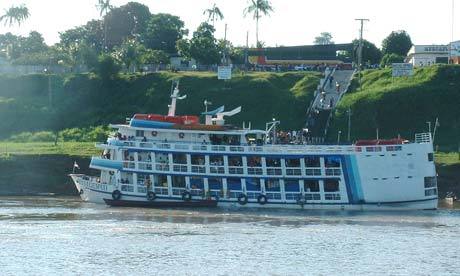
On my left a woman in pink leggings, green top and yellow scarf reached up to hang her facecloth over a beam. It was 1.30pm, the whole boat had just finished eating and we were all swinging gently in our hammocks. I had a view of the jungle and the muddy brown water, while above was a blue sky dotted with cumulus clouds. This was the Amazon, and it was wonderful.
Bruce Parry spent nine months travelling along the world's longest river for his latest TV series. But you don't have to be an ex-marine and an expert in indigenous tribes to get close to the Amazon and her people. All you need is a hammock.
I bought mine at one of the many tin-shack stores selling them in Tabatinga, a border town in the far west of Amazonas, Brazil. Three countries meet here: Brazil, Peru and Colombia. To get there we'd flown from Bogota, two hours over the rainforest, to Leticia, the Colombian part of Tabatinga. A walk in sapping heat across the porous frontier brought us to the river. Here we found a boat, the Sagrado Coracao de Jesus, the Sacred Heart of Jesus, moored and waiting at the river's muddy edge.
Five of these three-deck passenger ferries – built like old-style Mississippi steamers – ply the upper section of the river, between Tabatinga and Manaus, the Brazilian Amazonian capital of over a million people. The downstream journey takes three nights and four days – it takes longer going upstream.
The boat was empty, and we were welcomed onboard by the captain's wife who was wielding a broom – the ship was scrubbed and swept five times a day when we got moving. We would be leaving the next day at 3pm, she told us. In the meantime we could stay on board.
That first night, swinging under the stars on deck was quiet. The highlight of the day had been choosing a hammock, and we had nothing to do but share beers with the deckhands and watch them play cards. But by lunchtime the next day, the boat was crowded with people and the card-players were hard at work, loading cargo for the journey to Manaus.
This is the beauty of travelling like this along the Amazon – the people. There are 150 hammocks on each deck, giving each person about three feet of swing space. There is a kitchen and dining room, where passengers eat in shifts – 10 minutes, 30 at a time, at one big table. Fellow travellers are locals, heading to market or using the big ferry to get close to a tributary, where they are picked up by motor canoe, performing audacious mid-river transfers from ferry to river-taxi at full speed before waving and disappearing across the water to some unknown place. You can't see the other side.
This is a long, long way from anywhere. The overpowering feeling is one of space. Vast, undiluted space. There is the river, a mile across, though it's hard to tell. Then there is the rainforest, which is always changing, sometimes so dense it looks black, other times flooded, with stark dead trees rising above the canopy. And there are the people. The Amazon river is one vast highway and people live and work along its entire length.
Above all this is the sky. A typical day would start perfect, then clouds would build and by 4pm they were set to storm. On day one the rain fell in torrents. Those who knew what to do rolled down blue plastic side-sheeting and then we sat on our hammocks and listened as the rain battered down. Later, storm clouds hung ragged and spent against a yellow sunset, and then it was night. The moon rose. Later, we passed through clouds of flying bugs, which launched themselves at the lights and fell buzzing into T-shirts and hair. The day before we'd drifted through a cloud of blue butterflies.
After three days of this restful travelling, we reached Manaus. Along the way we'd seen river dolphins and giant catfish, been waylaid at muddy ports by fruit sellers and fiestas and it felt like we'd never get any closer. We saw the glow of it first, hours before we got there – a perfect dome of orange light stretched above a dark canopy of trees. We arrived at 10pm and in the hustle of docking only managed to say fleeting goodbyes to new friends – perhaps as it should be. Manaus by night was charmless compared to the river, and we stayed onboard, choosing hammock over hotel. At dawn we were woken by the metal clang of a big-city port at work. We stepped ashore and found a breakfast of sorts. Then the game of getting out of there began.
Getting there
Boats ply the Amazon all year round. Tickets can be bought locally from the ferry and usually include three meals a day. The journey described cost 150 Brazil reais (£41)

